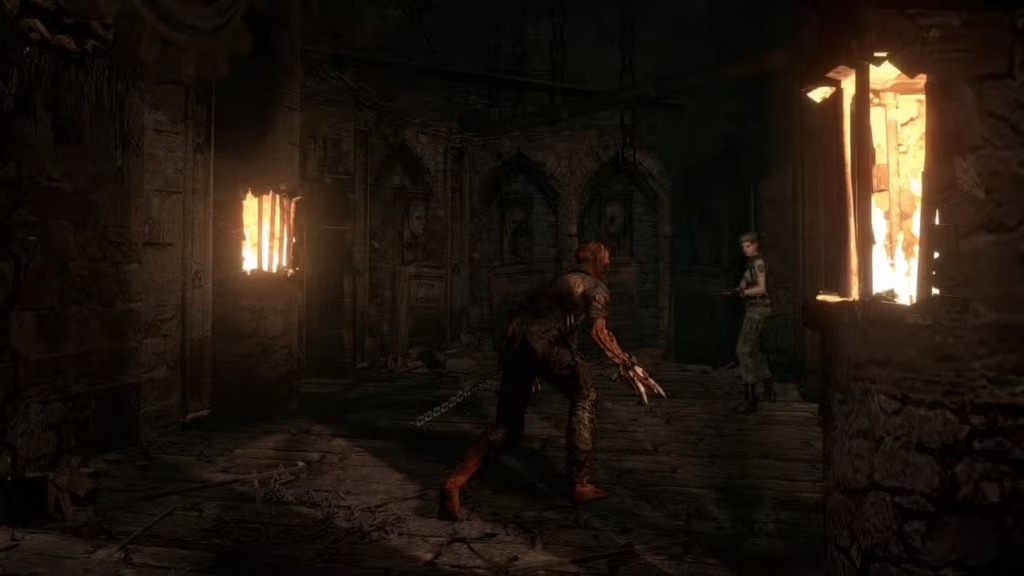
In this reimagining of Capcom’s 1996 classic, players are thrust once more into the nightmarish Spencer Mansion, where S.T.A.R.S. operatives Chris Redfield and Jill Valentine must investigate the disappearance of their fellow team members. What begins as a routine mission quickly spirals into a desperate fight for survival as they uncover the secrets of Umbrella Corporation’s bioweapons experiments.
Released in 2002 for the Nintendo GameCube, the remake of Resident Evil completely rebuilt the original title with new assets, voice acting, music, and reworked mechanics. Unlike a mere graphical upgrade, this version added entirely new areas, enemies, puzzles, and plot elements that expanded the lore. Notably, it introduced the haunting backstory of Lisa Trevor, a tragic figure tied to Umbrella’s experiments, adding depth and psychological weight to the horror.
Developed and published by Capcom, the remake initially launched exclusively on the Nintendo GameCube on March 22, 2002, in Japan, followed by later releases worldwide the same year. It was eventually ported to the Wii (2008), PlayStation 3, PlayStation 4, Xbox 360, Xbox One, and Windows PC through an HD remastered version released in 2015.
























Gameplay
The remake retained the survival horror foundation of the original limited ammunition, inventory management, fixed camera angles, and puzzle-solving while introducing new mechanics like defensive weapons (daggers, stun guns) to fend off enemies when grabbed. A notable addition was the “Crimson Head” system, where downed zombies could resurrect into faster, deadlier versions unless their bodies were burned or decapitated, heightening tension and resource management.
Visuals and Style
Graphically, the remake was a leap forward for the time, using pre-rendered backgrounds enhanced with dynamic lighting and atmospheric effects. Shadows, weather, and subtle sound design created a chillingly immersive environment. The art direction leaned heavily into gothic horror, with the mansion rendered as a decaying, labyrinthine nightmare. This visual fidelity established the game as one of the most atmospheric titles of its generation.
Importance in Survival Horror History
The Resident Evil remake is widely considered one of the best remakes in gaming history and a landmark in survival horror. It proved that remakes could transcend nostalgia by meaningfully reimagining and expanding upon an original work. It also refined the formula that defined the genre limited resources, oppressive atmosphere, and psychological dread cementing Capcom’s role as the leader of survival horror at the time. The Crimson Head mechanic, Lisa Trevor’s addition, and environmental storytelling advanced the genre’s emphasis on unpredictability and unease.
Reception vs Historical Value
Upon release, the game received critical acclaim for its visuals, tension, and faithful yet expanded adaptation of the original. Reviewers praised it as one of the scariest games ever made, though its deliberately slow pace and tank controls divided some players in the action-oriented early 2000s. Over time, however, it has been re-evaluated as a masterpiece of the genre, often ranked among the greatest survival horror games of all time. Historically, it set the gold standard for remakes and remains influential in how developers approach revitalizing classic titles.
Availability and Collectibility



The original GameCube version is considered highly collectible, specially complete-in-box (CIB) copies, as it never saw a wide reprint. The Wii version is less rare but still desirable among collectors. Thankfully, the 2015 Resident Evil HD Remaster made the game widely available on modern platforms, ensuring accessibility for new generations of players. Physical copies of the GameCube release remain a prized possession for survival horror enthusiasts and collectors.
Steam: https://store.steampowered.com/agecheck/app/304240/
PSN: Resident Evil
Trailer:
